An audit is a systematic, objective tool to assess regulatory or policy compliance in the workplace. An audit usually involves a survey of the workplace to:
- Identify what laws or regulations apply to a company or facility.
- Determine whether applicable regulations are being complied with.
- Determine whether company policies and procedures are being followed.
- Assess documentation practices.
- Identify any unwritten practices that should be formalized or changed.
Audits may be voluntary, or they may be required. In a voluntary audit, an employer decides on its own that it would be advantageous to conduct an audit, whether to evaluate compliance status or to identify any suspected problems.
Audits can be mandatory, however, if they are part of the settlement of an enforcement action between a governmental agency and your company. Audits also may be mandatory if they are required by a regulation. For example, some OSHA regulations, such as those governing process safety management, have self-audit requirements.
There are numerous benefits to an audit if it is properly conducted and acted upon. First, an audit can help to identify and correct regulatory non-compliance problems, which can help reduce liability.
Before you begin an audit, it’s important to determine the scope of the audit. A particular company many only want to examine its recruiting practices to ensure compliance with Equal Opportunity Employment laws. On the other hand, another employer may want to audit all of its human resources policies, procedures and systems.
Contact the MBA HR services team for more information on how they can help with an HR audit at hrservices@mbausa.org.
Stacey Bruce, SPHR, SHRM-SCP, is the director of HR Services at the Manufacturer & Business Association. Contact her at 814/833-3200, 800/815-2660 or sbruce@mbausa.org.












